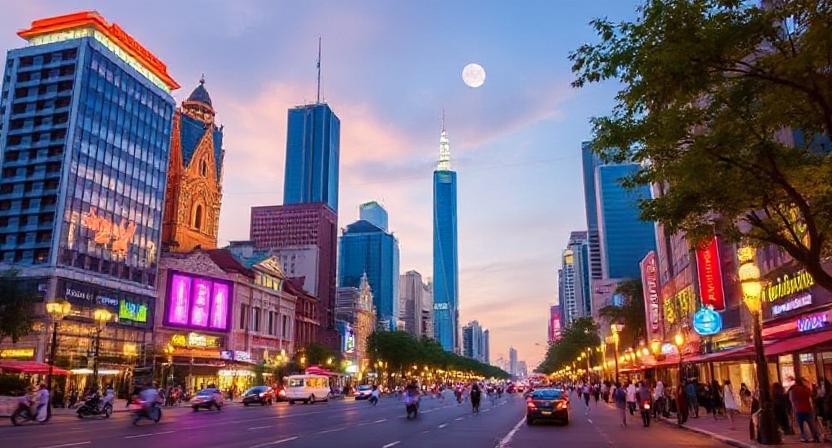Ho Chi Minh City Experiences Strong Tourism Growth in this Year with a More than Fifteen Percent Increase in International Arrivals, Focusing on its Wellness and Sustainable Tourism – Travel And Tour World

Ho Chi Minh City Tourism Sector Performance Report: 2025
Executive Summary
Ho Chi Minh City has demonstrated significant growth in its tourism sector throughout the first ten months of 2025. The city’s strategy, which emphasizes sustainable development, wellness tourism, and infrastructure enhancement, aligns closely with several United Nations Sustainable Development Goals (SDGs). This report details the city’s performance metrics, its strategic alignment with the SDGs, market diversification efforts, and future outlook.
Key Performance Indicators (January – October 2025)
- International Arrivals: 6.58 million visitors, achieving 65.9% of the annual target.
- Domestic Arrivals: 33.08 million visitors, achieving 66.2% of the annual goal.
- Tourism Revenue: 208.06 trillion VND (11.02 billion USD) in the first nine months, representing 71.7% of the full-year target.
- Public Transport Usage (October 2025): 55.1 million passengers, indicating high mobility within the city.
Strategic Alignment with Sustainable Development Goals (SDGs)
SDG 8: Decent Work and Economic Growth
The tourism sector’s robust performance is a primary driver of economic resilience and growth for Ho Chi Minh City. The substantial revenue generated directly contributes to the local economy. Furthermore, the sector’s expansion fosters job creation across multiple industries, including:
- Hospitality and Accommodation
- Transportation and Logistics
- Retail and Food Services
- Cultural and Recreational Services
This growth supports local businesses and promotes community engagement, ensuring that economic benefits are widely distributed, which is a core tenet of SDG 8.
SDG 3: Good Health and Well-being
A key strategic focus for the city is the development of medical and wellness tourism. This initiative directly supports SDG 3 by promoting health-centric travel. Key actions include:
- Launching inter-regional tourism products that connect Ho Chi Minh City with the Mekong Delta, integrating healthcare, wellness retreats, and spa services.
- Positioning the city as a leading destination for holistic health experiences, catering to a growing global demand.
- Creating a people-centered tourism model that nurtures local communities while providing world-class wellness services.
SDG 9 & SDG 11: Industry, Innovation, and Infrastructure & Sustainable Cities and Communities
Modern and sustainable infrastructure is central to the city’s tourism strategy, directly contributing to SDG 9 and SDG 11. The development of resilient infrastructure enhances visitor accessibility and promotes sustainable urban living.
- Sustainable Transport: The Ben Thanh-Suoi Tien metro line, which served 1.8 million passengers in October, is a critical component of an eco-friendly public transport system that reduces urban congestion and carbon emissions.
- Modernized Accommodation: The city is upgrading its hotel infrastructure with a focus on green building standards and sustainable operations to accommodate the rising number of travelers responsibly.
- Enhanced Connectivity: The integration of transportation hubs with cultural sites and commercial districts creates a more accessible and sustainable urban environment for both residents and tourists.
SDG 12: Responsible Consumption and Production
Ho Chi Minh City is actively implementing measures to ensure sustainable consumption and production patterns within its tourism industry. This forward-thinking approach is vital for long-term resilience and aligns with SDG 12.
- Promotion of eco-friendly transportation options for tourists.
- Support for hotels and businesses that adopt green and sustainable practices.
- Encouragement of sustainable consumption across retail and dining sectors to reduce the industry’s overall carbon footprint.
Market Diversification and International Engagement
Expansion into Eastern European Markets
Recent policy changes have successfully broadened the city’s international appeal, reflecting progress toward SDG 17 (Partnerships for the Goals) by strengthening global ties. Following the implementation of a new visa exemption policy on August 15, 2025, data indicates a significant increase in interest from new source markets.
- Accommodation searches for Vietnam from Eastern European markets increased by 59%.
- Ho Chi Minh City ranked as the third most-searched destination in the country, with a 56% increase in search volume from this region.
This data confirms the effectiveness of simplified entry procedures in attracting new tourist demographics and expanding the city’s global reach.
Future Outlook and Strategic Direction
The outlook for Ho Chi Minh City’s tourism industry remains positive. The city’s commitment to a development model rooted in sustainability, innovation, and inclusivity positions it for continued success. Future growth will be driven by:
- Continued investment in sustainable infrastructure and public transportation.
- Expansion of diversified tourism products, particularly in wellness and eco-tourism.
- Strategic marketing to attract and develop new international source markets.
- Deepening the integration of SDG principles into all facets of the tourism sector to ensure long-term resilience and responsible growth.
Analysis of Sustainable Development Goals in the Article
1. Which SDGs are addressed or connected to the issues highlighted in the article?
-
SDG 3: Good Health and Well-being
- The article highlights Ho Chi Minh City’s focus on promoting “medical tourism” and “wellness travel.” It mentions initiatives to create tourism products that integrate “healthcare, wellness, and cultural experiences,” directly contributing to the well-being of visitors.
-
SDG 8: Decent Work and Economic Growth
- This is a central theme of the article. It details significant growth in tourism revenue (208.06 trillion VND), international and domestic visitor numbers, and the overall contribution of the tourism sector to the city’s economic resilience. The text also explicitly states that the sector “contributes significantly to job creation and local development, with employment opportunities in hospitality, transportation, retail, and cultural tourism.”
-
SDG 9: Industry, Innovation, and Infrastructure
- The article emphasizes the role of modern infrastructure in driving tourism. It points to the development of the “Ben Thanh–Suoi Tien metro line” and the modernization of the “public transport system” and “hotel infrastructure” as critical components of the city’s tourism strategy to enhance accessibility and connectivity.
-
SDG 11: Sustainable Cities and Communities
- The focus on developing a modern public transport system, including the metro, to improve mobility for tourists and locals aligns with making cities more sustainable. Furthermore, the article mentions initiatives connecting the city with the Mekong Delta to promote “cultural landscapes” and “traditional villages,” which relates to protecting cultural heritage.
-
SDG 12: Responsible Consumption and Production
- The article explicitly mentions the city’s commitment to “sustainable tourism initiatives.” It details efforts to reduce the industry’s environmental impact by “promoting eco-friendly transportation, supporting green hotels, and encouraging sustainable consumption practices,” which are core principles of this SDG.
2. What specific targets under those SDGs can be identified based on the article’s content?
-
Target 8.9: “By 2030, devise and implement policies to promote sustainable tourism that creates jobs and promotes local culture and products.”
- The article’s entire focus on growing tourism in a sustainable manner, creating “employment opportunities,” and promoting “cultural experiences” in regions like the Mekong Delta directly aligns with this target.
-
Target 9.1: “Develop quality, reliable, sustainable and resilient infrastructure… to support economic development and human well-being.”
- The development of the “Ben Thanh-Suoi Tien Line” and the modernization of “Tan Son Nhat International Airport” and hotel infrastructure are presented as key drivers for tourism growth and economic development, matching this target.
-
Target 11.2: “By 2030, provide access to safe, affordable, accessible and sustainable transport systems for all.”
- The article highlights the city’s expanding public transport system, including the new metro line, which handled “55.1 million passengers” in a month, enhancing visitor accessibility and improving connectivity within the city.
-
Target 11.4: “Strengthen efforts to protect and safeguard the world’s cultural and natural heritage.”
- The strategy to create inter-regional tourism products connecting Ho Chi Minh City with the Mekong Delta, which is known for its “stunning waterways and cultural landscapes,” demonstrates an effort to leverage and promote cultural and natural heritage for tourism.
-
Target 12.b: “Develop and implement tools to monitor sustainable development impacts for sustainable tourism…”
- The city’s focus on a “sustainable, people-centered tourism model” and specific efforts to reduce the “carbon footprint of its tourism industry” by promoting “eco-friendly transportation” and “green hotels” are direct actions towards implementing and monitoring sustainable tourism.
3. Are there any indicators mentioned or implied in the article that can be used to measure progress towards the identified targets?
-
Economic Indicators:
- Total tourism revenue: “208.06 trillion VND (11.02 billion USD) by the end of the first nine months.”
- Number of international visitors: “6.58 million international visitors recorded in the first 10 months of 2025.”
- Number of domestic visitors: “33.08 million visitors.”
-
Infrastructure Usage Indicators:
- Number of passengers using the public transport system: “55.1 million passengers” in October 2025.
- Number of passengers on the Ben Thanh–Suoi Tien metro line: “1.8 million passengers.”
- Number of air travel passengers: “3.3 million passengers at Tan Son Nhat International Airport.”
-
Market Growth Indicators:
- Increase in accommodation searches from European markets: “searches for Vietnam accommodation have increased by 59%,” with Ho Chi Minh City seeing a “56% increase in search volume.”
-
Sustainable Tourism Indicators (Implied):
- Development of new tourism products: Creation of “inter-regional tourism products that integrate healthcare, wellness, and cultural experiences.”
- Adoption of sustainable practices: The article mentions efforts to promote “eco-friendly transportation,” support “green hotels,” and encourage “sustainable consumption,” which can be measured through policy implementation and industry certification.
-
Employment Indicators (Implied):
- Job creation: The article states that the tourism sector contributes to “employment opportunities in hospitality, transportation, retail, and cultural tourism,” implying that the number of jobs in these sectors is a key indicator of progress.
4. Table of SDGs, Targets, and Indicators
| SDGs | Targets | Indicators |
|---|---|---|
| SDG 3: Good Health and Well-being | Promote well-being through tourism. |
|
| SDG 8: Decent Work and Economic Growth | Target 8.9: Promote sustainable tourism that creates jobs and promotes local culture. |
|
| SDG 9: Industry, Innovation, and Infrastructure | Target 9.1: Develop quality, reliable, sustainable and resilient infrastructure. |
|
| SDG 11: Sustainable Cities and Communities | Target 11.2: Provide access to sustainable transport systems. Target 11.4: Protect cultural and natural heritage. |
|
| SDG 12: Responsible Consumption and Production | Target 12.b: Develop and implement tools to monitor sustainable development impacts for sustainable tourism. |
|
Source: travelandtourworld.com
What is Your Reaction?
 Like
0
Like
0
 Dislike
0
Dislike
0
 Love
0
Love
0
 Funny
0
Funny
0
 Angry
0
Angry
0
 Sad
0
Sad
0
 Wow
0
Wow
0
















































/environment-climate-change-and-health-(ech)/water-sanitation-hygiene-and-health-(wsh)/landfill-tuvalu-36092.tmb-1200v.jpg?sfvrsn=5c21fe40_1#)

.jpg.webp?itok=0ZsAnae9#)

























